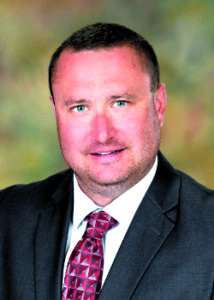Firefighter hired as emergency planning administrator for county

Conner O'Halloran
YOUNGSTOWN — Mahoning County’s Emergency Management Agency has a new member on its leadership team.
On Thursday morning, Mahoning County commissioners approved the hiring of Conner O’Halloran as the new emergency planning and E911 administrator.
The EMA, according to its website, is tasked with the developing and maintaining a countywide all-hazards emergency operations plan and is responsible for the coordination, organization and administration of all emergency management functions.
EMA Director Robin Lees said the agency’s board voted unanimously to hire O’Halloran after meeting with all candidates two weeks ago.
O’Halloran, 36, is a Boardman resident and has served simultaneously for several years as a captain in Canfield’s Cardinal Joint Fire District and as an assistant chief in Poland’s Western Reserve Joint Fire District. He has resigned from Cardinal to accept the new position, but will remain a part-time assistant chief in Poland.
“I’m really excited about it, because that’s my background,” he said. “I’ll be coordinating the big events whether it’s scheduled or the unscheduled emergencies.”
A Boardman graduate, O’Halloran earned his associate and bachelor’s degrees and received his paramedic training at Youngstown State University. He obtained a master’s degree in emergency management from Eastern Kentucky University.
“I’m excited to utilize some of my background and education, and I hope to make a lot of good changes,” he said.
O’Halloran replaces Maggie McGee as E911 administrator, but said the EMA restructured the role to include emergency planning.
“The big focus is blending public and private entities and making sure they’re coordinated and prepared to respond,” O’Halloran said.
He said it’s all about conversations and O’Halloran has been a big part of some of the most important conversations of that sort in recent months. While not a member of the Austintown-Boardman-Mahoning County Joint Communications District executive board, he did participate actively in the discussions about transitioning the county to the state-operated MARCS radio system.
MARCS is a state-sponsored system that allows emergency responders from different agencies to communicate directly through their radios, instead of funneling communications through multiple dispatch centers, which costs time in an emergency.
MARCS will allow local law enforcement, for example, to tie into the MARCS system anywhere in Ohio, easing communications with local and regional agencies in the case of prisoner transfers to and from out-of-county facilities.
O’Halloran also is on the executive board of Mahoning County’s Incident Management Assist Team (IMAT), which was designed to facilitate better planning, communication, and resource availability and organization across the county.
O’Halloran said both the MARCS move and the IMAT are all about ensuring the county is well prepared for anything. The East Palestine train derailment and the explosion at Realty Tower in downtown Youngstown last year were the primary motivation for both efforts.
O’Halloran said his job will be to coordinate with the directors of the county’s 911 centers,
maintain state compliance for emergency services — along with the corresponding statistics, facilitate and oversee training for dispatch centers, including emergency medical dispatch training and mass casualty training, and — if declarations of emergency are ever necessary — coordinating with state or federal officials for funding and higher-level support.
He’ll also coordinate the continuing education emergency management agencies and officials in the county.
“My role is the mediator, I need to make sure the conversations happen to get everyone on the same page,” he said. “Because those conversations have saved us.”
O’Hallaron said the role involves everything from making sure that each community’s dispatch center and / or emergency responders know exactly what they need to do if an emergency happens in their community, making sure everyone knows the flow of communication and even organizing the daily conversations the county needs to have with state and federal agencies.
“For example, like today, with the heat index, we get briefings about that from the National Weather Service office in Cleveland,” he said.
Emergencies can come from unexpected places, O’Halloran said.
“When it’s this hot, people are using a lot more electricity, and the lines can melt from both the ambient heat and overusage. That can cause a mass casualty situation,” he said. “Suddenly, you have 80-some elderly people without AC, then what are you going to do?”
He’ll also help plan contingencies for events such as Y-Live or the Canfield Fair.
O’Halloran will make $85,000 per year in the position.




